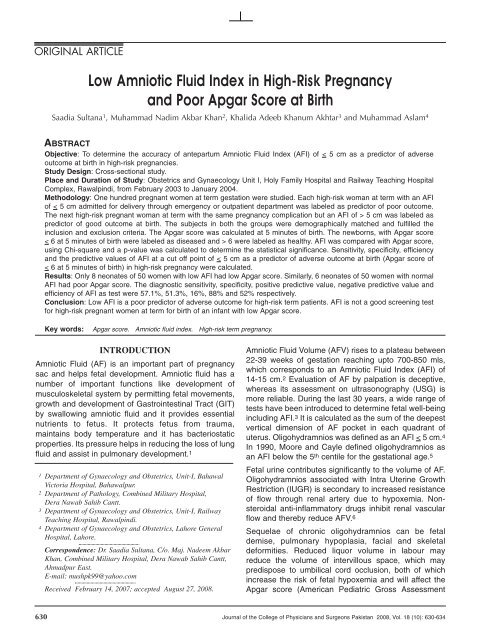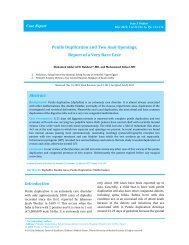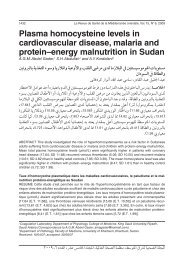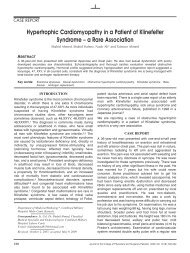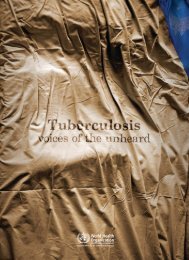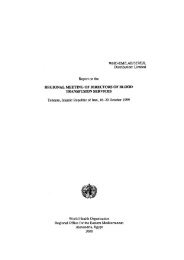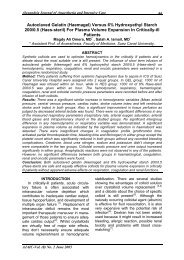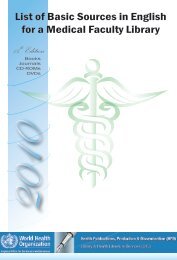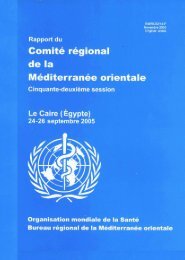Low Amniotic Fluid Index in High-Risk Pregnancy and Poor Apgar ...
Low Amniotic Fluid Index in High-Risk Pregnancy and Poor Apgar ...
Low Amniotic Fluid Index in High-Risk Pregnancy and Poor Apgar ...
You also want an ePaper? Increase the reach of your titles
YUMPU automatically turns print PDFs into web optimized ePapers that Google loves.
ORIGINAL ARTICLE<br />
<strong>Low</strong> <strong>Amniotic</strong> <strong>Fluid</strong> <strong>Index</strong> <strong>in</strong> <strong>High</strong>-<strong>Risk</strong> <strong>Pregnancy</strong><br />
<strong>and</strong> <strong>Poor</strong> <strong>Apgar</strong> Score at Birth<br />
Saadia Sultana 1 , Muhammad Nadim Akbar Khan 2 , Khalida Adeeb Khanum Akhtar 3 <strong>and</strong> Muhammad Aslam 4<br />
ABSTRACT<br />
Objective: To determ<strong>in</strong>e the accuracy of antepartum <strong>Amniotic</strong> <strong>Fluid</strong> <strong>Index</strong> (AFI) of < 5 cm as a predictor of adverse<br />
outcome at birth <strong>in</strong> high-risk pregnancies.<br />
Study Design: Cross-sectional study.<br />
Place <strong>and</strong> Duration of Study: Obstetrics <strong>and</strong> Gynaecology Unit I, Holy Family Hospital <strong>and</strong> Railway Teach<strong>in</strong>g Hospital<br />
Complex, Rawalp<strong>in</strong>di, from February 2003 to January 2004.<br />
Methodology: One hundred pregnant women at term gestation were studied. Each high-risk woman at term with an AFI<br />
of < 5 cm admitted for delivery through emergency or outpatient department was labeled as predictor of poor outcome.<br />
The next high-risk pregnant woman at term with the same pregnancy complication but an AFI of > 5 cm was labeled as<br />
predictor of good outcome at birth. The subjects <strong>in</strong> both the groups were demographically matched <strong>and</strong> fulfilled the<br />
<strong>in</strong>clusion <strong>and</strong> exclusion criteria. The <strong>Apgar</strong> score was calculated at 5 m<strong>in</strong>utes of birth. The newborns, with <strong>Apgar</strong> score<br />
< 6 at 5 m<strong>in</strong>utes of birth were labeled as diseased <strong>and</strong> > 6 were labeled as healthy. AFI was compared with <strong>Apgar</strong> score,<br />
us<strong>in</strong>g Chi-square <strong>and</strong> a p-value was calculated to determ<strong>in</strong>e the statistical significance. Sensitivity, specificity, efficiency<br />
<strong>and</strong> the predictive values of AFI at a cut off po<strong>in</strong>t of < 5 cm as a predictor of adverse outcome at birth (<strong>Apgar</strong> score of<br />
< 6 at 5 m<strong>in</strong>utes of birth) <strong>in</strong> high-risk pregnancy were calculated.<br />
Results: Only 8 neonates of 50 women with low AFI had low <strong>Apgar</strong> score. Similarly, 6 neonates of 50 women with normal<br />
AFI had poor <strong>Apgar</strong> score. The diagnostic sensitivity, specificity, positive predictive value, negative predictive value <strong>and</strong><br />
efficiency of AFI as test were 57.1%, 51.3%, 16%, 88% <strong>and</strong> 52% respectively.<br />
Conclusion: <strong>Low</strong> AFI is a poor predictor of adverse outcome for high-risk term patients. AFI is not a good screen<strong>in</strong>g test<br />
for high-risk pregnant women at term for birth of an <strong>in</strong>fant with low <strong>Apgar</strong> score.<br />
Key words:<br />
<strong>Apgar</strong> score. <strong>Amniotic</strong> fluid <strong>in</strong>dex. <strong>High</strong>-risk term pregnancy.<br />
INTRODUCTION<br />
<strong>Amniotic</strong> <strong>Fluid</strong> (AF) is an important part of pregnancy<br />
sac <strong>and</strong> helps fetal development. <strong>Amniotic</strong> fluid has a<br />
number of important functions like development of<br />
musculoskeletal system by permitt<strong>in</strong>g fetal movements,<br />
growth <strong>and</strong> development of Gastro<strong>in</strong>test<strong>in</strong>al Tract (GIT)<br />
by swallow<strong>in</strong>g amniotic fluid <strong>and</strong> it provides essential<br />
nutrients to fetus. It protects fetus from trauma,<br />
ma<strong>in</strong>ta<strong>in</strong>s body temperature <strong>and</strong> it has bacteriostatic<br />
properties. Its pressure helps <strong>in</strong> reduc<strong>in</strong>g the loss of lung<br />
fluid <strong>and</strong> assist <strong>in</strong> pulmonary development. 1<br />
1 Department of Gynaecology <strong>and</strong> Obstetrics, Unit-I, Bahawal<br />
Victoria Hospital, Bahawalpur.<br />
2 Department of Pathology, Comb<strong>in</strong>ed Military Hospital,<br />
Dera Nawab Sahib Cantt.<br />
3 Department of Gynaecology <strong>and</strong> Obstetrics, Unit-I, Railway<br />
Teach<strong>in</strong>g Hospital, Rawalp<strong>in</strong>di.<br />
4 Department of Gynaecology <strong>and</strong> Obstetrics, Lahore General<br />
Hospital, Lahore.<br />
Correspondence: Dr. Saadia Sultana, C/o. Maj. Nadeem Akbar<br />
Khan, Comb<strong>in</strong>ed Military Hospital, Dera Nawab Sahib Cantt,<br />
Ahmadpur East.<br />
E-mail: mushpk99@yahoo.com<br />
Received February 14, 2007; accepted August 27, 2008.<br />
<strong>Amniotic</strong> <strong>Fluid</strong> Volume (AFV) rises to a plateau between<br />
22-39 weeks of gestation reach<strong>in</strong>g upto 700-850 mls,<br />
which corresponds to an <strong>Amniotic</strong> <strong>Fluid</strong> <strong>Index</strong> (AFI) of<br />
14-15 cm. 2 Evaluation of AF by palpation is deceptive,<br />
whereas its assessment on ultrasonography (USG) is<br />
more reliable. Dur<strong>in</strong>g the last 30 years, a wide range of<br />
tests have been <strong>in</strong>troduced to determ<strong>in</strong>e fetal well-be<strong>in</strong>g<br />
<strong>in</strong>clud<strong>in</strong>g AFI. 3 It is calculated as the sum of the deepest<br />
vertical dimension of AF pocket <strong>in</strong> each quadrant of<br />
uterus. Oligohydramnios was def<strong>in</strong>ed as an AFI < 5 cm. 4<br />
In 1990, Moore <strong>and</strong> Cayle def<strong>in</strong>ed oligohydramnios as<br />
an AFI below the 5 th centile for the gestational age. 5<br />
Fetal ur<strong>in</strong>e contributes significantly to the volume of AF.<br />
Oligohydramnios associated with Intra Uter<strong>in</strong>e Growth<br />
Restriction (IUGR) is secondary to <strong>in</strong>creased resistance<br />
of flow through renal artery due to hypoxemia. Nonsteroidal<br />
anti-<strong>in</strong>flammatory drugs <strong>in</strong>hibit renal vascular<br />
flow <strong>and</strong> thereby reduce AFV. 6<br />
Sequelae of chronic oligohydramnios can be fetal<br />
demise, pulmonary hypoplasia, facial <strong>and</strong> skeletal<br />
deformities. Reduced liquor volume <strong>in</strong> labour may<br />
reduce the volume of <strong>in</strong>tervillous space, which may<br />
predispose to umbilical cord occlusion, both of which<br />
<strong>in</strong>crease the risk of fetal hypoxemia <strong>and</strong> will affect the<br />
<strong>Apgar</strong> score (American Pediatric Gross Assessment<br />
630 Journal of the College of Physicians <strong>and</strong> Surgeons Pakistan 2008, Vol. 18 (10): 630-634
<strong>Low</strong> AFI <strong>in</strong> high-risk pregnancy <strong>and</strong> poor <strong>Apgar</strong> score at birth<br />
Record) of baby at birth. <strong>Apgar</strong> score is conventionally<br />
determ<strong>in</strong>ed at 1 <strong>and</strong> 5 m<strong>in</strong>utes. It describes cardiorespiratory<br />
or neurological depression of the newborn.<br />
<strong>Low</strong> <strong>Apgar</strong> score signifies a problem that needs<br />
explanation <strong>and</strong> management. In some high-risk<br />
pregnancies, the decl<strong>in</strong>e <strong>in</strong> AFI can be at a faster rate<br />
<strong>and</strong> it may be wise to determ<strong>in</strong>e AFI once <strong>and</strong><br />
sometimes twice weekly. 7 Patients with AFI < 5 cm<br />
should be admitted <strong>in</strong> the hospital. 8 Determ<strong>in</strong>ation of<br />
optimal time of delivery is necessary <strong>and</strong> labour should<br />
not be prolonged. 9 It has been observed that antepartum<br />
or <strong>in</strong>trapartum AFI < 5 cm is associated with<br />
significant <strong>in</strong>crease <strong>in</strong> risk of <strong>Low</strong>er Segment Caesarean<br />
Section (LSCS) for fetal distress <strong>and</strong> low <strong>Apgar</strong> score at<br />
5 m<strong>in</strong>utes (<strong>Apgar</strong> score < 6). 10<br />
The current local practices relies heavily on AFI<br />
estimation, particularly <strong>in</strong> the management of prolonged<br />
pregnancy <strong>and</strong> IUGR. 11-13 The role of AFI as an isolated<br />
predictor of fetal outcome needs to be checked not only<br />
<strong>in</strong> prolonged pregnancies, but also <strong>in</strong> other frequently<br />
managed high-risk pregnancies.<br />
The aim of this study was to determ<strong>in</strong>e the accuracy of<br />
AFI estimation on neonatal outcome.<br />
METHODOLOGY<br />
This study was carried out <strong>in</strong> Obstetrics <strong>and</strong><br />
Gynaecology Unit I, Holy Family Hospital <strong>and</strong> Railway<br />
Teach<strong>in</strong>g Hospital Complex, Rawalp<strong>in</strong>di. Out of<br />
pregnant women admitted <strong>in</strong> Obstetrics ward / Labour<br />
room for delivery through emergency or outpatient<br />
department, 100 women at term were selected dur<strong>in</strong>g<br />
one year period from February 2003 to January 2004 by<br />
non-probability purposive sampl<strong>in</strong>g technique.<br />
Subjects were demographically matched <strong>and</strong> fulfilled<br />
the <strong>in</strong>clusion <strong>and</strong> exclusion criteria. The study was<br />
limited to women with non-anomalous s<strong>in</strong>gleton fetus<br />
with cephalic presentation between 37 <strong>and</strong> 42 weeks of<br />
gestation. Pregnant women with post-dated<br />
pregnancies, pregnancy <strong>in</strong>duced hypertension, chronic<br />
hypertension, IUGR, diabetics <strong>and</strong> undiagnosed highrisk<br />
pregnancies were <strong>in</strong>cluded <strong>in</strong> the study. In<br />
‘undiagnosed high-risk pregnancies group’ the patients<br />
who were high-risk but could not be adjusted <strong>in</strong> first five<br />
categories <strong>and</strong> were found to be moderately or severely<br />
anaemic, malnourished, smokers or suffer<strong>in</strong>g from any<br />
acute/chronic illness.<br />
Pregnant women with preterm rupture of membranes,<br />
congenital abnormalities of fetus, hemolytic diseases of<br />
fetus, multiple pregnancies, breech pregnancy,<br />
antepartum hemorrhage, preterm labour <strong>and</strong> pregnancy<br />
with fetal death were excluded from the study, as <strong>in</strong><br />
these conditions poor outcome at birth is expected due<br />
to obvious reasons other than low AFI.<br />
The expected date of delivery was calculated from<br />
menstrual dates or ultrasound <strong>in</strong> early pregnancy. After<br />
appropriate consent, patient was assessed us<strong>in</strong>g a<br />
questionnaire that <strong>in</strong>cluded demographic <strong>in</strong>formation,<br />
history of menstrual cycle, last menstrual period, parity,<br />
medical <strong>and</strong> surgical history. Information data were<br />
collected from the patients, their case notes <strong>and</strong><br />
antenatal book<strong>in</strong>g cards. Information obta<strong>in</strong>ed was<br />
recorded on specially-designed proforma for study.<br />
Each high-risk woman at term with an AFI of < 5 cm was<br />
<strong>in</strong>cluded <strong>in</strong> the study, followed by next high-risk<br />
pregnant woman with an AFI of > 5 cm <strong>and</strong> the same<br />
pregnancy complication.<br />
For USG assessment, all patients had ur<strong>in</strong>ated with<strong>in</strong><br />
half an hour prior to AFI estimation. The women were<br />
<strong>in</strong> sup<strong>in</strong>e position for USG exam<strong>in</strong>ation. Expert<br />
Ultrasonologist performed all ultrasound exam<strong>in</strong>ations<br />
with convex probe of 3.75 MHz. AFI was calculated<br />
with<strong>in</strong> 72 hours of delivery (pre-partum or <strong>in</strong>trapartum <strong>in</strong><br />
1st stage of labour). The AFI was calculated by divid<strong>in</strong>g<br />
the maternal abdomen <strong>in</strong>to 4 quadrants us<strong>in</strong>g the<br />
umbilicus <strong>and</strong> l<strong>in</strong>ea nigra as reference markers.<br />
Measurements of the deepest pool <strong>in</strong> each quadrant<br />
were summated <strong>and</strong> AFI was recorded <strong>in</strong> cm<br />
(centimeters). Mode of delivery (vag<strong>in</strong>al, elective LSCS<br />
or emergency LSCS) <strong>and</strong> per<strong>in</strong>atal management was at<br />
the discretion of obstetrician <strong>in</strong>-charge. The <strong>Apgar</strong> score<br />
of the newborn was calculated at 5 m<strong>in</strong>utes of birth by<br />
attend<strong>in</strong>g neonatologist, who was unaware of the<br />
ultrasound f<strong>in</strong>d<strong>in</strong>gs. All these <strong>in</strong>formation were recorded<br />
on the data sheet.<br />
The high-risk pregnant women with AFI of < 5 cm were<br />
labeled as predictor of poor outcome at birth. The highrisk<br />
pregnant women with AFI of > 5 cm were labeled as<br />
predictor of good outcome at birth. The newborn with<br />
<strong>Apgar</strong> score < 6 at 5 m<strong>in</strong>utes of birth were labeled as<br />
diseased <strong>and</strong> newborn with <strong>Apgar</strong> score of > 6 at 5<br />
m<strong>in</strong>utes of birth were labeled as healthy.<br />
Statistical package for social sciences version 11.0 was<br />
used for data compilation <strong>and</strong> analysis. The AFI was<br />
compared with <strong>Apgar</strong> score, us<strong>in</strong>g Chi-square (x 2 ), <strong>and</strong><br />
p-value was calculated to determ<strong>in</strong>e the statistical<br />
significance. Student’s t-test was used to compare age,<br />
gestational age <strong>and</strong> number of children. P-value < 0.05<br />
was taken as significant. Four factors considerd for<br />
analysis of results were sensitivity, specificity, efficiency<br />
<strong>and</strong> the predictive values.<br />
RESULTS<br />
The demographics of patients gestational age <strong>and</strong> parity<br />
are shown <strong>in</strong> Table I. <strong>Low</strong> AFI group had three extra<br />
nulliparas. Multiparas were more <strong>in</strong> normal AFI. The<br />
difference was not statistically significant (p=0.3).<br />
The frequency of different risks <strong>in</strong> pregnancy <strong>in</strong>cluded<br />
25% post-dated pregnancies, 23% pregnancy-<strong>in</strong>duced<br />
hypertension, 16% chronic hypertension, 14%<br />
<strong>in</strong>trauter<strong>in</strong>e growth restriction, 5% diabetics <strong>and</strong> 17%<br />
Journal of the College of Physicians <strong>and</strong> Surgeons Pakistan 2008, Vol. 18 (10): 630-634 631
Saadia Sultana, Muhammad Nadim Akbar Khan, Khalida Adeeb Khanum Akhtar <strong>and</strong> Muhammad Aslam<br />
Table I: Demographic variables <strong>and</strong> relationship of parity with AFI<br />
<strong>in</strong> study population (n=100).<br />
Variable Normal AFI (> 5cm) <strong>Low</strong> AFI (≤ 5 cm) P-value<br />
Maternal age (years) 28.00 mean 30.00 mean 0. 69 (NS)<br />
(+ 5.4) (+ 6.2) -<br />
Gestational age (week) 38.06 38.02 0.76 (NS)<br />
(+ 1.03) (+ 0.9) -<br />
Multipara 34 (68%) 29 (58%) 0.3<br />
Nullipara 16 (32%) 21 (42%) 0.3<br />
Values <strong>in</strong> brackets with + refer to st<strong>and</strong>ard deviation; Values <strong>in</strong> brackets with % refer to<br />
percentages; NS = Non-specific<br />
were undiagnosed. Those were the patients who were<br />
high-risk but could not be adjusted <strong>in</strong> the other 5<br />
categories <strong>and</strong> were found to be moderately or severely<br />
anaemic, malnourished, smokers or suffer<strong>in</strong>g from any<br />
acute/chronic illness.<br />
Onset of labour was spontaneous <strong>in</strong> nearly two-third of<br />
women. Induction of labour was required <strong>in</strong> a quarter of<br />
high-risk pregnant women <strong>and</strong> 12 women had to<br />
undergo elective LSCS shown <strong>in</strong> Table II. Caesarean<br />
sections had to be done <strong>in</strong> a quarter of all the cases.<br />
Table II also shows that there were more elective LSCS<br />
<strong>in</strong> normal AFI than low AFI women. However, more<br />
<strong>in</strong>ductions of labour were done <strong>in</strong> low AFI than normal<br />
AFI women. There was a statistically significant<br />
difference between the two groups (p = 0.04). AVD<br />
(assisted vag<strong>in</strong>al delivery), LSCS <strong>and</strong> SVD<br />
(spontaneous vag<strong>in</strong>al delivery) were nearly of equal<br />
number <strong>in</strong> both groups. The difference was not<br />
statistically significant (p=0.8).<br />
Table II: Relationship of AFI with <strong>in</strong>duction of labour, mode of delivery<br />
<strong>and</strong> neonatal outcome (n=100).<br />
Variable Frequency Normal <strong>Low</strong> P-value<br />
AFI AFI<br />
(> 5 cm) (< 5 cm)<br />
Spontaneous labour 64 35 29 0.57<br />
Induced labour 24 07 17 0.04<br />
Vag<strong>in</strong>al delivery 76 39 37 0.8<br />
SVD 65 34 31 -<br />
AVD 11 05 06 -<br />
LSCS( Elective+Emergency) 24 11 13 0.8<br />
<strong>Low</strong> birth weight (< 2.5 kg ) 15 6 9 0.4<br />
Normal birth weight (≥ 2.5 kg) 85 44 41<br />
<strong>Poor</strong> <strong>Apgar</strong> score at 5 m<strong>in</strong>utes (≤ 6) 14 6 8 0.25<br />
Normal <strong>Apgar</strong> score at 5 m<strong>in</strong>utes (> 6) 86 44 42<br />
AVD: Assisted Vag<strong>in</strong>al Delivery; SVD: Spontaneous Vertex Delivery; LSCS: <strong>Low</strong>er Segment<br />
Caesarean Section<br />
There was no significant association between gender<br />
<strong>and</strong> AFI (p=0.8) <strong>and</strong> the difference <strong>in</strong> birth weight was<br />
not significant between the two groups of AFI (p=0.4).<br />
Table II shows that 14 out of 100 babies had poor <strong>Apgar</strong><br />
score at 5 m<strong>in</strong>utes after birth. Two neonates had major<br />
morbidity (meconium aspiration <strong>and</strong> birth asphyxia).<br />
There were no per<strong>in</strong>atal deaths. Out of those 14, 8 had<br />
low AFI dur<strong>in</strong>g their antenatal period <strong>and</strong> 6 had normal<br />
AFI. On the other h<strong>and</strong>, there were 42 babies with<br />
normal <strong>Apgar</strong> score <strong>in</strong> low AFI group <strong>and</strong> 44 <strong>in</strong> normal<br />
AFI group (p=0.25).<br />
For analysis of results, sensitivity, specificity <strong>and</strong> the<br />
predictive values of AFI were considered at a cut off<br />
po<strong>in</strong>t of < 5 cm as a predictor of adverse outcome at<br />
birth (<strong>Apgar</strong> score of < 6 at 5 m<strong>in</strong>utes of birth) <strong>in</strong> highrisk<br />
pregnancy.<br />
Sensitivity of AFI as a predictor of poor <strong>Apgar</strong> score at<br />
5 m<strong>in</strong>utes of birth calculated by this data was 57.1%,<br />
specificity was 51.3%, Positive Predictive Value (PPV)<br />
was 16%, Negative Predictive Value (NPV) was 88%<br />
<strong>and</strong> overall efficiency of the test was 52%.<br />
DISCUSSION<br />
AFI provides a quantitative result that is proportional to<br />
actual volume <strong>and</strong> more predictive than other methods.<br />
It is well-established that oligohydramnios is associated<br />
with a high-risk of adverse per<strong>in</strong>atal outcome. 14<br />
This study showed that patients with unfavourable<br />
maternal <strong>and</strong>/or fetal conditions, such as IUGR,<br />
diabetes or hypertension etc, usually have poor <strong>Apgar</strong><br />
score at 5 m<strong>in</strong>utes of birth <strong>in</strong> 14% of cases. It means that<br />
86% of women with same high-risk conditions gave birth<br />
to babies with normal <strong>Apgar</strong> score at 5 m<strong>in</strong>utes of birth.<br />
This study <strong>in</strong>dicated that oligohydramnios <strong>in</strong> high-risk<br />
pregnancies led to poor outcome at birth than normal<br />
AFV with the same high-risk conditions. The difference<br />
between the two groups was negligible <strong>and</strong> not<br />
statistically significant. Similar results were found by<br />
Zhang et al. 15<br />
Magann et al. also compared high-risk women with AFI<br />
of ≤ 5 cm with subjects who had a similar diagnosis of<br />
pregnancy complications but an AFI of more than 5 cm.<br />
They found no difference <strong>in</strong> <strong>in</strong>trapartum complications,<br />
caesarean delivery for fetal distress or neonatal<br />
outcomes. 16 In another study, Barrilleaux <strong>and</strong> Magann<br />
concluded that antepartum/<strong>in</strong>trapartum performance of<br />
AFI <strong>in</strong> patients with the HELLP syndrome is a poor<br />
prognostic test for subsequent fetal compromise. 17<br />
Similar results are shown <strong>in</strong> this study. Thus, it can be<br />
suggested that immediate delivery for pregnancies with<br />
oligohydramnios may not be necessary when there are<br />
no other features present, which are suggestive of fetal<br />
distress. Each high-risk condition itself may predispose<br />
to adverse neonatal outcome. Therefore, it is not entirely<br />
clear whether the adverse neonatal outcomes merely<br />
reflected the sequel of other conditions or if reduced<br />
AFV itself contributed to the adverse outcomes.<br />
Voxman concluded that antepartum oligohydramnios is<br />
not a predictor of adverse per<strong>in</strong>atal outcome as<br />
measured by low <strong>Apgar</strong> score <strong>and</strong> Neonatal Intensive<br />
Care Unit (NICU) admissions <strong>and</strong> that good outcome<br />
may be due to the aggressive antepartum <strong>and</strong><br />
<strong>in</strong>trapartum management these patients received. 18<br />
Morris concluded that AFI is superior to a measure of<br />
the s<strong>in</strong>gle deepest pool as an assessment of fetus at or<br />
632 Journal of the College of Physicians <strong>and</strong> Surgeons Pakistan 2008, Vol. 18 (10): 630-634
<strong>Low</strong> AFI <strong>in</strong> high-risk pregnancy <strong>and</strong> poor <strong>Apgar</strong> score at birth<br />
after 40 weeks but has a poor sensitivity for adverse<br />
pregnancy outcome. 19 He also suggested, as <strong>in</strong> this<br />
study, that frequent use of USG at term may lead to<br />
<strong>in</strong>crease obstetric <strong>in</strong>tervention without improvement <strong>in</strong><br />
per<strong>in</strong>atal outcomes. 19<br />
An Italian study concluded that <strong>in</strong> pregnancies with<br />
oligohydramnios, the modality of delivery <strong>and</strong> neonatal<br />
outcome did not differ from those with normal AFV. 20<br />
Although there is a statistically significant association of<br />
AFI with <strong>in</strong>duction of labour, there is no significant<br />
difference <strong>in</strong> mode of delivery <strong>and</strong> neonatal outcome<br />
between normal <strong>and</strong> low AFI groups. The sensitivity of<br />
an AFI < 5 cm for the prediction of severe morbidity is<br />
unfortunately low. This means that any sign of<br />
deteriorat<strong>in</strong>g fetal condition might have prompted<br />
<strong>in</strong>duction <strong>and</strong> immediate delivery. This selective<br />
confound<strong>in</strong>g may have, to some extent, biased the<br />
per<strong>in</strong>atal outcomes. So a r<strong>and</strong>omized cl<strong>in</strong>ical trial is<br />
necessary <strong>in</strong> which women with AFI < 5 cm will be<br />
r<strong>and</strong>omly assigned, either to immediate delivery or to<br />
expectant management, may provide a more def<strong>in</strong>itive<br />
answer.<br />
The significant proportion of neonates with poor <strong>Apgar</strong><br />
score has an AFI > 5 cm. It <strong>in</strong>dicates that other tests of<br />
fetal well-be<strong>in</strong>g are necessary to detect the fetuses that<br />
are at risk of adverse outcome <strong>in</strong> the presence of normal<br />
AFI. Another reason of low sensitivity of AFI estimation<br />
may be due to the fact that colour Doppler ultrasound<br />
was not used. However, the use of colour Doppler<br />
imag<strong>in</strong>g has been reported to overdiagnose<br />
oligohydramnios. 21<br />
Use of 3-D USG <strong>and</strong> MRI may circumvent this problem<br />
<strong>and</strong> more accurate results can be obta<strong>in</strong>ed. An<br />
ultrasound may be <strong>in</strong>conclusive <strong>in</strong> fetuses with renal<br />
diseases that result <strong>in</strong> anhydramnios or oligohydramnios.<br />
In such cases, further <strong>in</strong>vestigation with MRI<br />
should be considered. 22 The only objective assessment<br />
of fetal well-be<strong>in</strong>g is neonatal acidosis. As suggested <strong>in</strong><br />
a meta analysis, a multi-center study with sufficient<br />
power should be undertaken to demonstrate that a low<br />
AFI is associated with an umbilical arterial pH of < 7. 10<br />
Although antepartum or <strong>in</strong>trapartum oligohydramnios is<br />
not a predictor of adverse per<strong>in</strong>atal outcome <strong>in</strong> high-risk<br />
pregnant ladies, as measured by low <strong>Apgar</strong> score at 5<br />
m<strong>in</strong>utes, this may be reflective of aggressive<br />
antepartum <strong>and</strong> <strong>in</strong>trapartum management, which was<br />
provided to those patients. A more def<strong>in</strong>itive answer<br />
may be obta<strong>in</strong>ed by a cl<strong>in</strong>ical trial <strong>in</strong> which women with<br />
AFI ≤ 5 cm will be r<strong>and</strong>omly assigned either to<br />
immediate delivery or to expectant management.<br />
CONCLUSION<br />
AFI is a poor predictor of adverse outcome for high-risk<br />
antepartum or <strong>in</strong>trapartum pregnant ladies. The only<br />
significant association between low AFI <strong>and</strong> labour<br />
<strong>in</strong>duction reveals that the early <strong>in</strong>tervention due to low<br />
AFI <strong>in</strong> high-risk parturients lead to more alert attitude of<br />
the obstetricians, which may lead to some confound<strong>in</strong>g.<br />
The conclusion that AFI is not a good predictor of<br />
outcome may be reflective of aggressive antepartum or<br />
<strong>in</strong>trapartum management that the patients with<br />
oligohydramnios received.<br />
REFERENCES<br />
1. Nicol<strong>in</strong>i U, Fisk NM, Rodeck CH, Talbert DG, Wigglesorth JS.<br />
<strong>Low</strong> amniotic pressure <strong>in</strong> oligohydramnios – is this cause of<br />
pulmonary hypoplasia? Am J Obstet Gynecol 1989; 161:1098-101.<br />
2. Brace RA, Wolf EJ. Normal amniotic fluid volume changes<br />
throughout pregnancy. Am J Obstet Gynecol 1989; 161:382-8.<br />
3. Murrey E, Keirse MJ. Assessment of fetal growth, size <strong>and</strong> wellbe<strong>in</strong>g.<br />
A guide to effective care <strong>in</strong> pregnancy <strong>and</strong> childbirth. 3rd<br />
ed. Oxford: Oxford University Press; 2000.p.80-92.<br />
4. Phelan JP, Smith CV, Broussard P, Small M. <strong>Amniotic</strong> fluid<br />
volume assessment with the four-quadrant technique at 36-42<br />
weeks gestation. J Reprod Med 1987; 32:540-2.<br />
5. Moore TR, Cayle JE. The amniotic fluid <strong>in</strong>dex <strong>in</strong> normal human<br />
pregnancy. Am J Obstet Gynecol 1990; 162:1168-73.<br />
6. Florescu A, Koren G. Non-steroidal anti-<strong>in</strong>flammatory drugs for<br />
rheumatoid arthritis dur<strong>in</strong>g pregnancy. Can Fam Physicians 2005;<br />
51:961-2.<br />
7. Banks EH, Miller DA. Per<strong>in</strong>atal risks associated with borderl<strong>in</strong>e<br />
amniotic fluid <strong>in</strong>dex. Am J Obstet Gynecol 1999; 180:1461-3.<br />
8. Ghosh G, Marsal K, Gudmundsson S. <strong>Amniotic</strong> fluid <strong>in</strong>dex <strong>in</strong> low<br />
risk pregnancy as test for an admission to the labour ward.<br />
Acta Obstet Gynecol Sc<strong>and</strong> 2002; 81:852-5.<br />
9. Kawasaki N, Nishimura H, Yoshimura T, Okamura H. A<br />
dim<strong>in</strong>ished <strong>in</strong>trapartum amniotic fluid <strong>in</strong>dex is a predictive<br />
marker of possible adverse neonatal outcome when associated<br />
with prolonged labour. Gynecol Obstet Invest 2002; 53:1-5.<br />
10. Chauhan SP, S<strong>and</strong>erson M, Hendrix NW, Megann EF, Devoe<br />
LD. Per<strong>in</strong>atal outcome <strong>and</strong> amniotic fluid <strong>in</strong>dex <strong>in</strong> the<br />
antepartum <strong>and</strong> <strong>in</strong>trapartum periods: a meta-analysis.<br />
Am J Obstet Gynecol 1999; 181:1473-8.<br />
11. Hassan AA. The role of amniotic fluid <strong>in</strong>dex <strong>in</strong> the management<br />
of postdate pregnancy. J Coll Physicians Surg Pak 2005; 15:85-8.<br />
12 . Iqbal S. Management of prolonged pregnancy. J Coll Physicians Surg<br />
Pak 2004; 14:274-7.<br />
13. Ahmed Khan DB, Bari V, Chishty IA. Ultrasound <strong>in</strong> the diagnosis<br />
<strong>and</strong> management of <strong>in</strong>trauter<strong>in</strong>e growth retardation.<br />
J Coll Physicians Surg Pak 2004; 14:601-4.<br />
14. Casey BM, McIntire DD, Bloom SL. <strong>Pregnancy</strong> outcomes after<br />
antepartum diagnosis of oligohydramnios at or beyond 34<br />
weeks gestation. Am J Obstet Gynecol 2000; 182:909-12.<br />
15. Zhang J, Troendle J, Meikle S, Klebanoff MA, Rayburm WF.<br />
Isolated oligohydramnios is not associated with adverse<br />
per<strong>in</strong>atal outcomes. Br J Obstet Gynaecol 2004; 111:220-5.<br />
16. Magann EF, K<strong>in</strong>sella MJ, Chauhan SP, Mc Namara MF,<br />
Gehrung BW, Morrison JC. Does an amniotic fluid <strong>in</strong>dex of ≤ 5<br />
cm necessitate delivery <strong>in</strong> high-risk pregnancies? A case control<br />
study. Am J Obstet Gynecol 1999; 180:1354-9.<br />
17. Barrilleaux PS, Magann EF, Chauhan SP, York BM, Philibert L,<br />
Lewis DF. <strong>Amniotic</strong> fluid <strong>in</strong>dex as a predictor of adverse<br />
per<strong>in</strong>atal outcome <strong>in</strong> the HELLP syndrome. J Reprod Med 2007;<br />
52:293-8.<br />
18. Voxman EG, Trans S, W<strong>in</strong>g DA. <strong>Low</strong> amniotic fluid <strong>in</strong>dex as a<br />
Journal of the College of Physicians <strong>and</strong> Surgeons Pakistan 2008, Vol. 18 (10): 630-634 633
Saadia Sultana, Muhammad Nadim Akbar Khan, Khalida Adeeb Khanum Akhtar <strong>and</strong> Muhammad Aslam<br />
predictor of adverse per<strong>in</strong>atal outcome. J Per<strong>in</strong>atol 2002; 22:<br />
282-5.<br />
19. Morris JM, Thompson K, Smithey J, Gaffney G, Cooke I, et al.<br />
The usefulness of ultrasound assessment of amniotic fluid <strong>in</strong><br />
predict<strong>in</strong>g adverse outcome <strong>in</strong> prolonged pregnancy: a<br />
prospective bl<strong>in</strong>ded observational study. Br J Obstet Gynaecol 2003;<br />
110:989-94.<br />
20. Pasqu<strong>in</strong>i L, Nasto R, Mie ME, Giuliani B, Periti E. <strong>Amniotic</strong> fluid<br />
analysis as a screen<strong>in</strong>g test <strong>in</strong> term <strong>and</strong> post-term pregnancy.<br />
M<strong>in</strong>erva G<strong>in</strong>ecol 2003; 55:69-73.<br />
21. Magann EF, Chauhan SP, Barrillaeux PS, Whitworth NS,<br />
McCurley S, Mart<strong>in</strong> JN. Ultrasound estimate of amniotic fluid<br />
volume, colour Doppler overdiagnosis of oligohydramnios.<br />
Obstet Gynecol 2001; 98:71-4.<br />
22. Homan M, Brugger PC, Balassy C, Witzani L, Prayer D. Fetal<br />
MRI of the ur<strong>in</strong>ary system. EurJ Radiol 2006; 57:303-11.<br />
● ● ● ● ●✯● ● ● ● ●<br />
634 Journal of the College of Physicians <strong>and</strong> Surgeons Pakistan 2008, Vol. 18 (10): 630-634


